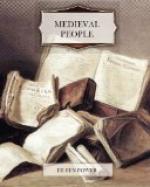Thousands of miles away from Venice, across the
lands and seas of Asia, a little south of the
Yangtze River and close to the sea stood the city of
Kinsai or Hangchow, the capital of the Sung emperors,
who ruled Southern China, not yet (in 1268) conquered
by the Tartars.[11] Like Venice, Kinsai stood
upon lagoons of water and was intersected by
innumerable canals. It was a hundred miles
in circuit, not counting the suburbs which stretched
round it, and there was not a span of ground which
was not well peopled. It had twelve great
gates, and each of the twelve quarters which
lay within the gates was greater than the whole
of Venice. Its main street was two hundred feet
wide, and ran from end to end of the city, broken
every four miles by a great square, lined with
houses, gardens, palaces, and the shops of the
artisans, who were ruled by its twelve great
craft gilds. Parallel with the main street was
the chief canal, beside which stood the stone
warehouses of the merchants who traded with India.
Twelve thousand stone bridges spanned its waterways,
and those over the principal canals were high
enough to allow ships with their tapering masts
to pass below, while the carts and horses passed overhead.
In its market-places men chaffered for game and peaches,
sea-fish, and wine made of rice and spices; and in
the lower part of the surrounding houses were
shops, where spices and drugs and silk, pearls
and every sort of manufactured article were sold.
Up and down the streets of Kinsai moved lords
and merchants clad in silk, and the most beautiful
ladies in the world swayed languidly past in embroidered
litters, with jade pins in their black hair and jewelled
earrings swinging against their smooth cheeks.[12]
On one side of this city lay a beautiful lake (famous in Chinese history, and still one of the fairest prospects upon earth), studded with wooded islands, on which stood pavilions with charming names: ‘Lake Prospect’, ‘Bamboo Chambers’, ’The House of the Eight Genii’, and ‘Pure Delight’. Here, like the Venetians, the men of Kinsai came for pleasure parties in barges, nobly hung and furnished, the cabins painted with flowers and mountain landscapes, and looking out they saw on one side the whole expanse of the city, its palaces, temples, convents, and gardens, and on the other the stretch of clear water, crowded with coloured pleasure boats, over which came echoing the high, clear voices and the tinkling instruments of the revellers. There is no space in which to tell of the King’s palace, with its gardens and orchards, its painted pavilions, and the groves where the palace ladies coursed the game with dogs, and, tired of the pastime, flung off their robes and ran to the lake, where they disported themselves like a shoal of silver fishes. But a word must be said of the junks, which came sailing into the harbour four and twenty miles away, and up the river to the city; and of the great concourse of ships which came to Zaiton (perhaps the modern Amoy),




